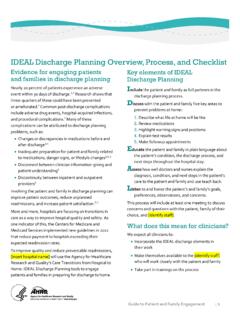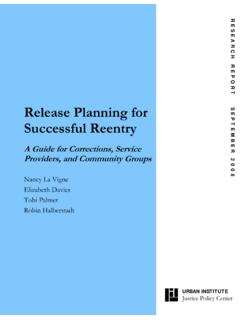Transcription of IRO Handbook - GOV.UK
1 IRO HandbookStatutory guidance for independent reviewing officers and local authorities on their functions in relation to case management and review for looked after children 1 Statutory guidance for independent reviewing officers and local authorities on their functions in relation to case management and review for looked after children Contents Chapter 1. Introduction 4 Aims and audience 4 Status of the guidance 5 Definitions 5 The legal context 7 The practice context 8 Chapter 2. An overview of the IRO role and functions 9 The care planning and review context 9 Core functions, tasks and responsibilities 10 Competences and qualifications 11 Independence 12 Chapter 3. IRO responsibilities in the care planning and review process 13 The care plan 13 planning the review meeting 13 preparation 14 Interpreters 15 Advocacy 15 Attendance and location 16 Timing of review meetings 17 Adjournment of reviews 17 Administration 18 The review: a child centred meeting 18 Issues to consider at the review 20 Statutory requirements 20 Safeguarding 21 Child s developmental needs 22 Permanence planning 24 Issues in relation to adoption 25 Information that must be provided to children at the review 27 Legal status 27 Outcomes from the review 28 Review record 28 Decisions and recommendations 29 Monitoring the case on an ongoing basis 30 2 IRO Handbook Chapter 4.
2 Considerations for specific groups of children 33 Children receiving short breaks 33 Children with additional communication needs 34 Children within the youth justice system 34 Children subject to secure accommodation orders 35 Children admitted to hospital 36 Unaccompanied asylum seeking children 36 Chapter 5. planning transition to adulthood 37 Eligible children 39 Young people leaving care 41 Young people with a disability 41 Chapter 6. Dispute resolution and complaints 43 Complaints 44 Provision of independent legal advice 44 Chapter 7. Strategic and management responsibilities 46 Establishing an effective IRO service 46 Appointment of the IRO 46 Administration of the review process 47 Management 47 Role and functions of the IRO manager 47 Caseloads 49 Role of the director of children s services 50 Interagency and interdepartmental working together 50 Delay and drift 51 Emergency placements 52 Chapter 8.
3 Cafcass 53 Family proceedings 53 Referral to Cafcass 54 3 Statutory guidance for independent reviewing officers and local authorities on their functions in relation to case management and review for looked after children References 57 Annex 2. Overview of care planning , placement and case Annex 4. Involving children with additional Annex 1. Overview of statutory framework for care planning 60 review process 61 Annex 3. Key changes to the IRO role and function 62 communication needs 64 Annex 5. Children in the youth justice system 68 4 IRO Handbook Chapter 1. Introduction Aims and audience This statutory document seeks to improve outcomes for looked after children by providing guidance to independent reviewing officers (IROs) about how they should discharge their distinct responsibilities to looked after children.
4 It also provides guidance to local authorities on their strategic and managerial responsibilities in establishing an effective IRO service. The aim is to give all looked after children the support and services that each one requires to enable them to reach their potential. The guidance draws on models of best practice already established throughout the country. It is published as a Handbook with the aim of providing a format that IROs will find easy to use and enable them to share information about their role with those with whom they work, for example: social workers; other children s services staff; professionals in other agencies; foster carers; the child; and parents and other relevant adults. When consulted about an early draft of this guidance, children and young people were clear what they wanted from their IRO: When they meet the child they should do this one to one so that the child can talk freely.
5 They must check with both the child, and other people working with the child, on whether the child is OK and happy where they are living and with their care plans. They must regularly ask each child whether they are happy with how things are being done for them, and keep checking what is happening for each child against that child s plans and the decisions made at their reviews. We have aimed to keep the voices of children and young people consistently in mind as we have drawn up this guidance. 5 Statutory guidance for independent reviewing officers and local authorities on their functions in relation to case management and review for looked after children Status of the guidance The guidance is issued under two provisions: The Children and Young Persons Act 2008, which created a new power for the Secretary of State to issue statutory guidance to IROs;1 and section 7 of the Local Authority Social Services Act 1970, which requires local authorities, in the exercise of their social services functions, to act under the general guidance of the Secretary of State; unless there are exceptional reasons local authorities must follow the requirements set out in this guidance.
6 This guidance replaces the 2004 It should be read in conjunction with the Care planning , Placement and Case Review (England) Regulations 20103 ( the Regulations ). The guidance is issued as part of a suite of statutory guidance which, together with the Regulations, sets out how local authorities should carry out the full range of responsibilities in relation to care planning , placement and review for looked after children. Annex 1 shows how these and other documents fit together within an overall framework, the aim of which is to provide looked after children with the most appropriate placement to meet their needs and improve their outcomes. Definitions References in this guidance to: the 1989 Act are to sections of the Children Act 1989; the 2008 Act are to sections of the Children and Young Persons Act 2008; the 2004 Act are to sections of the Children Act 2004; the 2002 Act are to sections of the Adoption and Children Act 2002; a numbered section of a Schedule is a reference to that section or Schedule in the 1989 Act; the Regulations are to the Care planning , Placement and Case Review (England) Regulations 2010 (where other regulations are referred to, the full title is used); and local authority is the local authority that is looking after an individual child (referred to as the responsible authority in the Regulations).
7 6 IRO Handbook The term child is used as an inclusive term to refer to all 0 to 18 year olds. Where the context specifically relates to older children, the term young person is used. The term looked after children refers, under the 1989 Act, to all children and young people being looked after by a local authority, namely: those subject to care orders or interim care orders (under sections 31 and 38 of the 1989 Act); those children who have been placed, or are authorised to be placed, with prospective adopters by a local authority (section 18(3) of the 2002 Act); those who are voluntarily accommodated under section 20 of the 1989 Act, including unaccompanied asylum-seeking children. Where children are accommodated under this provision, parental responsibility remains with the parents; and those who are subject to court orders with residence requirements (for example, secure remand or remand to local authority accommodation), in accordance with section 21 of the 1989 Act.
8 An eligible child , defined in paragraph 19B of Schedule 2 to the 1989 Act, and in regulation 41 of the Regulations, is a looked after child aged 16 or 17, who has been looked after for a total of at least 13 weeks which began after s/he reached the age of 14, and ends after s/he reaches the age of 16. A relevant child , defined in section 23A of the 1989 Act and regulation 4 of the Children (Leaving Care) (England) Regulations 2001, is a young person aged 16 or 17 who was an eligible child but is no longer looked after. A former relevant child , defined in section 23C of the 1989 Act is a young person aged 18 or above ( legally adult) who was either an eligible or relevant child. The local authority has functions and duties in relation to former relevant children until they reach the age of 21 (or 25 in the case of former relevant children who are pursuing a programme of education or training).
9 To assist the reader in cross-referencing this text to key sections of primary legislation or to the Regulations or other sets of regulations, this is signposted in the text as follows: [Primary legislation, 1989 Act] [Regulations; Part, Schedule or number] 7 Statutory guidance for independent reviewing officers and local authorities on their functions in relation to case management and review for looked after children The legal context A House of Lords judgement4 in 2002 concluded that a local authority that failed in its duties to a looked after child could be challenged under the Human Rights Act 1998, most likely under article 8 of the European Convention on Human Rights relating to family life. The judgement recognised that some children with no adult to act on their behalf may not have any effective means to initiate such a challenge.
10 In response, the Government made it a legal requirement for an IRO to be appointed to participate in case reviews, monitor the local authority s performance in respect of reviews, and to consider whether it would be appropriate to refer cases to the Children and Family Court Advisory and Support Service (Cafcass). This is set out in section 26 of the 1989 Act, as amended by the 2002 Act. Later, the Children and Family Court Advisory and Support Service (Reviewed Case Referral) Regulations 2004,5 made under section 26 of the 1989 Act, extended the functions of Cafcass so that on a referral from an IRO they could consider bringing proceedings for breaches of the child s human rights, judicial review and other proceedings. The 2008 Act extends the IRO s responsibilities from monitoring the performance by the local authority of their functions in relation to a child s review to monitoring the performance by the local authority of their functions in relation to a child s case, as set out in sections 25A-25C of the 1989 Act (inserted by section 10 of the 2008 Act).














